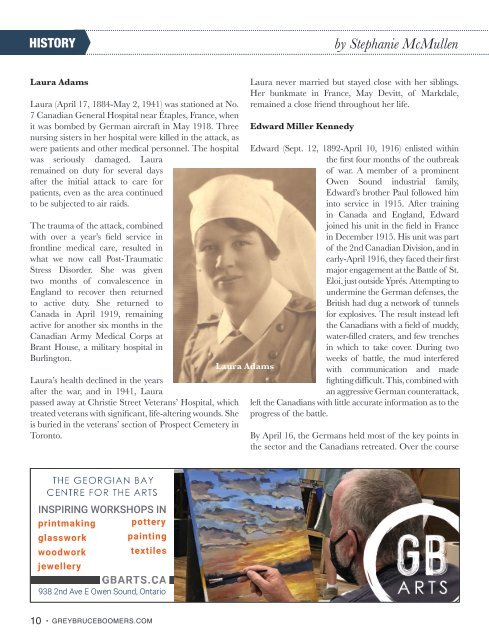Grey Bruce Boomers Fall 2021
Create successful ePaper yourself
Turn your PDF publications into a flip-book with our unique Google optimized e-Paper software.
HISTORY<br />
by Stephanie McMullen<br />
Laura Adams<br />
Laura (April 17, 1884-May 2, 1941) was stationed at No.<br />
7 Canadian General Hospital near Étaples, France, when<br />
it was bombed by German aircraft in May 1918. Three<br />
nursing sisters in her hospital were killed in the attack, as<br />
were patients and other medical personnel. The hospital<br />
was seriously damaged. Laura<br />
remained on duty for several days<br />
after the initial attack to care for<br />
patients, even as the area continued<br />
to be subjected to air raids.<br />
The trauma of the attack, combined<br />
with over a year’s field service in<br />
frontline medical care, resulted in<br />
what we now call Post-Traumatic<br />
Stress Disorder. She was given<br />
two months of convalescence in<br />
England to recover then returned<br />
to active duty. She returned to<br />
Canada in April 1919, remaining<br />
active for another six months in the<br />
Canadian Army Medical Corps at<br />
Brant House, a military hospital in<br />
Burlington.<br />
Laura’s health declined in the years<br />
after the war, and in 1941, Laura<br />
passed away at Christie Street Veterans’ Hospital, which<br />
treated veterans with significant, life-altering wounds. She<br />
is buried in the veterans’ section of Prospect Cemetery in<br />
Toronto.<br />
Laura Adams<br />
Laura never married but stayed close with her siblings.<br />
Her bunkmate in France, May Devitt, of Markdale,<br />
remained a close friend throughout her life.<br />
Edward Miller Kennedy<br />
Edward (Sept. 12, 1892-April 10, 1916) enlisted within<br />
the first four months of the outbreak<br />
of war. A member of a prominent<br />
Owen Sound industrial family,<br />
Edward’s brother Paul followed him<br />
into service in 1915. After training<br />
in Canada and England, Edward<br />
joined his unit in the field in France<br />
in December 1915. His unit was part<br />
of the 2nd Canadian Division, and in<br />
early-April 1916, they faced their first<br />
major engagement at the Battle of St.<br />
Eloi, just outside Yprés. Attempting to<br />
undermine the German defenses, the<br />
British had dug a network of tunnels<br />
for explosives. The result instead left<br />
the Canadians with a field of muddy,<br />
water-filled craters, and few trenches<br />
in which to take cover. During two<br />
weeks of battle, the mud interfered<br />
with communication and made<br />
fighting difficult. This, combined with<br />
an aggressive German counterattack,<br />
left the Canadians with little accurate information as to the<br />
progress of the battle.<br />
By April 16, the Germans held most of the key points in<br />
the sector and the Canadians retreated. Over the course<br />
10 • GREYBRUCEBOOMERS.COM

















